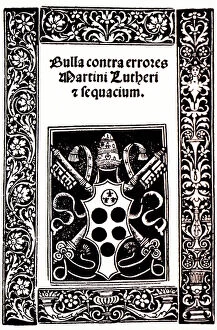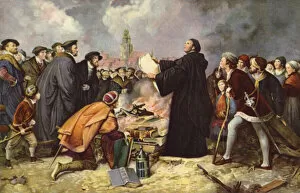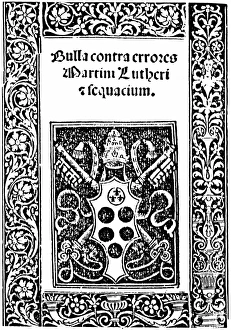Papal Bull Collection
"Papal Bull: The Power and Protest" Throughout history, the issuance of papal bulls has shaped the course of nations and sparked fiery debates
All Professionally Made to Order for Quick Shipping
"Papal Bull: The Power and Protest" Throughout history, the issuance of papal bulls has shaped the course of nations and sparked fiery debates. One such instance was King Henry II of England presenting the papal bull of 1155, granting him authority to invade, govern, and rule Ireland. This engraving captures a pivotal moment in Irish history. Another notable event occurred when Leo X pronounced the Bull of the Lords Steel. This powerful decree aimed to suppress heresy and maintain Catholic orthodoxy during a time when Martin Luther's teachings were gaining momentum. Luther himself responded by burning the Pope's bull in defiance, as depicted in an illustration from 'The Life and Times of Martin Luther. ' The clash between Luther and Rome continued with a papal bull issued by Pope Leo X against the erroneous Martin Luther. In response, Luther burned this very document in Wittenberg, Germany - an act that symbolized his rejection of papal authority. Papal bulls also played a role in transferring patronage rights within churches. A significant example is seen through a depiction of a papal bull transferring church patronage to Belgern. Centuries later, even Napoleon Bonaparte found himself entangled with these influential decrees. Preparatory notes for the Concordat highlight negotiations between Napoleon and Pope Pius VII regarding religious matters. In yet another historical twist involving England's monarchy, we witness Pope Clement VII issuing a bull against Henry VIII's divorce from Catherine of Aragon in 1530 – fueling tensions that would ultimately lead to England breaking away from Rome. Martin Luther remained at odds with Rome until his death; he became synonymous with protestant reform movements across Europe. An engraving portrays him defiantly burning yet another papal bull at Wittenberg – an iconic moment that encapsulates his unwavering commitment to challenging traditional Catholic doctrine. Martin Luther's legacy endures as one who dared question established norms while advocating for religious freedom and reform.














